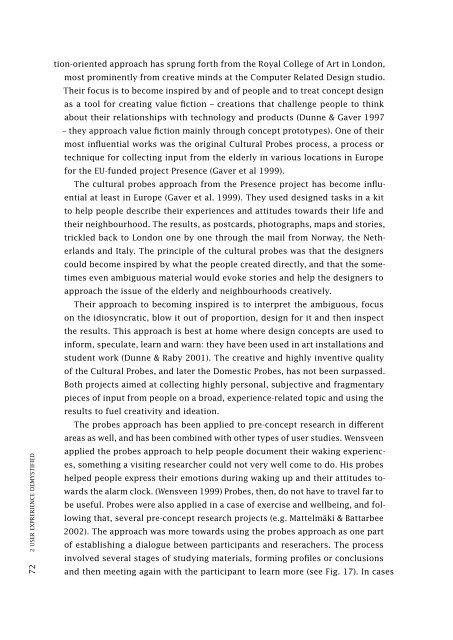Co-experience: Understanding user experiences in social interaction
Co-experience: Understanding user experiences in social interaction
Co-experience: Understanding user experiences in social interaction
You also want an ePaper? Increase the reach of your titles
YUMPU automatically turns print PDFs into web optimized ePapers that Google loves.
72 2 USER EXPRERIENCE DEMYSTIFIED<br />
tion-oriented approach has sprung forth from the Royal <strong>Co</strong>llege of Art <strong>in</strong> London,<br />
most prom<strong>in</strong>ently from creative m<strong>in</strong>ds at the <strong>Co</strong>mputer Related Design studio.<br />
Their focus is to become <strong>in</strong>spired by and of people and to treat concept design<br />
as a tool for creat<strong>in</strong>g value fiction – creations that challenge people to th<strong>in</strong>k<br />
about their relationships with technology and products (Dunne & Gaver 1997<br />
– they approach value fiction ma<strong>in</strong>ly through concept prototypes). One of their<br />
most <strong>in</strong>fluential works was the orig<strong>in</strong>al Cultural Probes process, a process or<br />
technique for collect<strong>in</strong>g <strong>in</strong>put from the elderly <strong>in</strong> various locations <strong>in</strong> Europe<br />
for the EU-funded project Presence (Gaver et al 1999).<br />
The cultural probes approach from the Presence project has become <strong>in</strong>fluential<br />
at least <strong>in</strong> Europe (Gaver et al. 1999). They used designed tasks <strong>in</strong> a kit<br />
to help people describe their <strong>experience</strong>s and attitudes towards their life and<br />
their neighbourhood. The results, as postcards, photographs, maps and stories,<br />
trickled back to London one by one through the mail from Norway, the Netherlands<br />
and Italy. The pr<strong>in</strong>ciple of the cultural probes was that the designers<br />
could become <strong>in</strong>spired by what the people created directly, and that the sometimes<br />
even ambiguous material would evoke stories and help the designers to<br />
approach the issue of the elderly and neighbourhoods creatively.<br />
Their approach to becom<strong>in</strong>g <strong>in</strong>spired is to <strong>in</strong>terpret the ambiguous, focus<br />
on the idiosyncratic, blow it out of proportion, design for it and then <strong>in</strong>spect<br />
the results. This approach is best at home where design concepts are used to<br />
<strong>in</strong>form, speculate, learn and warn: they have been used <strong>in</strong> art <strong>in</strong>stallations and<br />
student work (Dunne & Raby 2001). The creative and highly <strong>in</strong>ventive quality<br />
of the Cultural Probes, and later the Domestic Probes, has not been surpassed.<br />
Both projects aimed at collect<strong>in</strong>g highly personal, subjective and fragmentary<br />
pieces of <strong>in</strong>put from people on a broad, <strong>experience</strong>-related topic and us<strong>in</strong>g the<br />
results to fuel creativity and ideation.<br />
The probes approach has been applied to pre-concept research <strong>in</strong> different<br />
areas as well, and has been comb<strong>in</strong>ed with other types of <strong>user</strong> studies. Wensveen<br />
applied the probes approach to help people document their wak<strong>in</strong>g <strong>experience</strong>s,<br />
someth<strong>in</strong>g a visit<strong>in</strong>g researcher could not very well come to do. His probes<br />
helped people express their emotions dur<strong>in</strong>g wak<strong>in</strong>g up and their attitudes towards<br />
the alarm clock. (Wensveen 1999) Probes, then, do not have to travel far to<br />
be useful. Probes were also applied <strong>in</strong> a case of exercise and wellbe<strong>in</strong>g, and follow<strong>in</strong>g<br />
that, several pre-concept research projects (e.g. Mattelmäki & Battarbee<br />
2002). The approach was more towards us<strong>in</strong>g the probes approach as one part<br />
of establish<strong>in</strong>g a dialogue between participants and reserachers. The process<br />
<strong>in</strong>volved several stages of study<strong>in</strong>g materials, form<strong>in</strong>g profiles or conclusions<br />
and then meet<strong>in</strong>g aga<strong>in</strong> with the participant to learn more (see Fig. 17). In cases

















